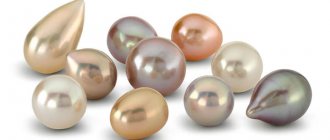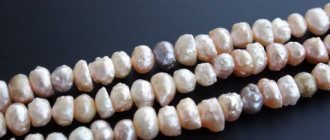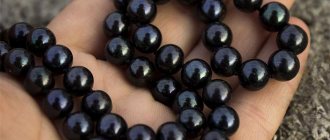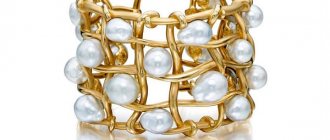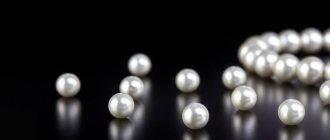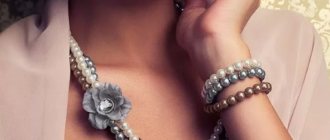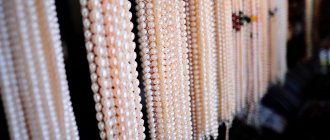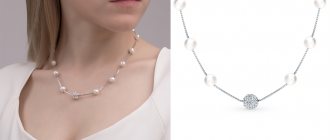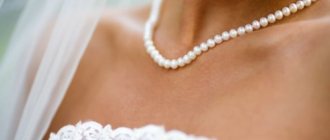The classic color of the mineral is white, with a bluish iris, but pearl tints are not always so strict and innocent. There are more than 120 shades of pearls in nature!
Blue, gray, purple, pink, gold and green, the rarest greenish-blue peas - not everyone knows these pearls. Of course, all of the listed shades are much rarer than white pearls.
Baroque pearls or baroque pearls
Baroque pearls
Gold bracelet with baroque pearls from Ray Griffiths
This is the general name for pearls that have an irregular original shape, regardless of their place of origin. Due to its unusualness and exclusivity, it is highly valued among many jewelry designers. Instead of the classic perfect ball, baroque pearls can resemble a drop, a disk, a cylinder, or a pear.
Especially notable are the so-called paragons - pearls that have the outlines of animals, human faces, bird wings, wolf fangs, etc. They have always been endowed with mystical properties and worn as talismans and amulets. In addition to their unusual shape, Baroque pearls are often distinguished by a ribbed pattern on the surface, similar to what sea waves leave on the sand.
Each pearl is unique and inimitable, so the demand and price for them remain at a consistently high level.
Mother of pearl in fans
Mother of pearl began to be used in decorating fans from the beginning of the 18th century. For a long time they used only the engraving technique; later they began to experiment with carving. Craftsmen cut fan plates from the shell and passed them on to a fan maker, who polished, engraved and turned the tips to perfection. The plates were then connected using a metal pin. The last stage of creating a fan - connecting the fan screen to the frame plates - is considered the most difficult.
Over time, the shape and decor of fans changed, following fashion trends. The fashion for the shade of the material itself also changed. For example, masters of the 18th century preferred white mother-of-pearl, decorating it with carvings, gilding and silvering. And in the 19th century, they began to use a variety of shades - from soft pink to deep blue and green.
The exhibition presents fans from the collection of the Ostankino museum-estate, created in France from the 18th to the beginning of the 20th century. They demonstrate different techniques for processing mother-of-pearl. For example, on the plates of the fan “The Delights of Country Life” (1770s) you can see relief carvings with silver and gold foil. And this wedding fan, created in the 1860s, depicts a scene of the bride getting ready. She is helped by her friends and cupids, and there are jewelry boxes around her. Mother-of-pearl plates develop the theme of decoration: they are completely covered with the finest carvings in the form of a gilded trellis mesh, often used in the Baroque and Rococo styles.
Pearl blister
Pearl blister in shells
Pendant with pearls blister from Nasonpearl
In some cases, the formation and growth of a pearl occurs on one of the inner sides of the shell. This leads to the fact that a pearlescent layer does not form at the site of its growth. Such pearls are less valued and undergo additional processing for use in jewelry.
Advertising - Continued below
Blister pearls have another, less common name - bubble pearls, which is due to their unusual appearance.
Therapeutic effect
Pearls are an indicator of the wearer's health. Tarnishing signals the owner about illness, giving a chance to resist health problems.
Other healing properties are known:
- Memory improvement.
- Regulation of the nervous system.
- Immune support.
- Protection against viruses, microbes.
- Improvement of the liver and kidneys.
- Normalization of blood pressure.
- Eye treatment.
The raw materials are used to make tinctures and powder to stop bleeding. Pearl water cleanses the body: an ordinary liquid in which the pearls have lain for half a day. One day has healing properties.
Tibetans believe that pearls have blood purifying properties. To do this, keep the stone in your mouth for 15 minutes every day.
Pearl soufflé
Airy pearl soufflé
Stud earrings with soufflé pearls and a ruby geode inside from Little h
The delicious name for pearls was invented by Jack Lynch, a recognized expert in this field. Such a comparison very accurately reflects the essence of the technology for its production. Translated from French, soufflé means “to inflate”, “to pump up”. In this case, the object of “inflation” is the pearl sac of the oyster after the formed pearl has been removed from it.
Dry earthy material is placed inside the soufflé pearl bag, which, gradually swelling with moisture, stretches it. The oyster continues to lay nacre around the new core, and thus grows pearls of impressive size, the quality and price of which depends on the thickness of the nacre layer.
Pearl Keshi
Pearl Keshi
Ring with Keshi pearl from Halleh
"Keshi" means "grain" in Japanese. These are pearls that can form in the shells of sea and freshwater oysters when they reject the main core. Despite the fact that the oyster did not accept an artificial implant, there remains a place in the pearl sac where the process of growth of layers of nacre occurs on small particles that naturally enter the shell from the outside, therefore such pearls are considered 100% natural.
Advertising - Continued below
Among cultured pearls, keshi is rare, since it is valued lower, and when an oyster rejects an implant, producers immediately replace it with a new one. Very often, keshi pearls come in a flattened shape, similar to a flower petal. And many jewelry designers love to use this quality.
GENERAL CHARACTERISTICS
A pearl forms when a foreign body enters the shell. The clam isolates the debris into a “pearl bag” and begins to wrap the intruder in layers of nacre (the same material that makes up the shell). Up to several dozen such aggregates can form inside one mollusk.
The more pearls in one shell, the smaller it is. For example, Black Sea mussels can form about 100 pearls, most of which will not exceed 2-3 mm in diameter.
All types of pearls have common physical properties.
| Compound | aragonite (mineral, one of the natural polymorphs of calcium carbonate (CaCO3) and conchiolin (horn-like organic substance) |
| Shine | pearl |
| Transparency | opaque, translucent |
| Hardness | 3-4 on the Mohs scale |
| Kink | shellish |
| Density | 2.60—2.78 g/cm³ |
| Refractive index | 1.52-1.66, black - 1.53-1.69 |
Despite their general physical properties, pearls are classified according to the following criteria:
- origin;
- configurations;
- colors;
- shine;
- defectiveness.
Kasumi pearls
Kasumi pearls
Beads made of expensive and rare kasumi pearls
Real kasumi is grown in Japan on Lake Kasumi-ga-ura. It is produced by oysters bred through selection in the 90s of the last century. The distinctive features of these pearls are their drop-shaped shape, bright rainbow shine, large size - up to 2 cm, and a variety of colors. The popularity of kasumi pearls is due to the growing number of analogues and fakes on the market.
Conch pearls
Conch pearls
Necklace with 32 conch pearls from Boghossian Jewel
Giant conch mollusks live in the Caribbean Sea. When the shell is opened, it dies, so conch pearls are not cultured. Caribbean pearls are difficult to confuse with others; in appearance they look more like small stones. Conch mollusks are not able to secrete mother-of-pearl, so their pearls do not have an iridescent sheen, but this does not make them any less beautiful.
Advertising - Continued below
The texture of this extraordinary pearl resembles wet silk, filled with frozen flashes of fire. The shape is usually regular - oval or spherical, but the color scheme is unique. There are pearls of olive, purple, and amber shades, but pink, purple and lilac specimens are considered the most valuable and rare.
Magic properties
What pearls are has been known since ancient times. Its magical symbolism and meaning are many-sided: longevity, eternal youth, material independence, fertility, strength of marriage bonds.
The magical properties of pearls help:
- Keep the house from thieves.
- Get rid of love pains.
- Protect yourself from mental negativity such as damage or the evil eye.
- Insure against unprofitable deals, evaluate the sincerity of partners.
- Calmly perceive your surroundings.
- Avoid mood swings.
There is no need for complex rituals; admiration is enough. Contemplation of pearl tints will calm, pacify, and harmonize the senses.
The stone has the ability to absorb human energy, along with diseases and habits that the new owner will receive. Therefore, precious gems rarely become family heirlooms. That is why it is better to buy a “clean”, unworn copy.
Akoya pearls (Akoya)
Akoya pearls
Fabergé bracelet with akoya pearls in white gold
The famous Japanese pearls are born in special bivalve mollusks Pinctada or in Japanese “akoya-kai”, hence its name. Among other types, this pearl is especially distinguished by its regular ball shape (it is these pearls that are most valued in jewelry and are most often used in jewelry) and light pure colors from pearly white to pale pink and silvery-greenish.
Mostly, the size of Akoya pearls reaches 6-8 mm; larger ones are extremely rare. High-quality pearls are classified as AAA or AA and are romantically called “floral”.
Presents from the island of Tahiti: what are they famous for
Black pearls are obtained from a special type of oyster of the pinctada maxima family. The mollusk lives near the coast of French Polynesia. Compared to other types of oysters, “black-lipped” oysters are the largest. The formations inside their shells are just as large, often dark in color with various variations of shades.
Cultivating pearls in pinctada maxima oysters is difficult primarily due to the high mortality of the organisms as a result of grafting. It is this factor that is associated with the demand for black pearls on the market. Dark mother-of-pearl beads are valued higher than light ones and are used to create exclusive jewelry. The average size of one bead is from 8 to 14 mm.
There are several shades of beads, ranging from gray to jet black or dark purple. Less common are specimens of pistachio, eggplant and dark green colors.
Abalone pearls
Abalone pearls. Photo: pearlparadise.com
Pendant with abalone pearls. Photo: jchapahernandez.com
Abalone is one of the very rare varieties of pearls. It is born in a single-vave mollusk of the same name, which is also called abalone or abalone. Due to the anatomical features of the mollusk, Abalone pearls are extremely difficult to cultivate.
Advertising - Continued below
Abalone mining is mainly carried out in the USA on the California coast and in Mexico. However, this type of pearl is often found in other countries, such as Japan, Australia, Korea, New Zealand, South Africa and Thailand.
The abalone mollusk is truly ancient, the age of the species is about 30 million years. But its main feature is the incredible palette of shades with which the inner surface of the shell shimmers - the pearl born in it can boast of the same play of colors. Blue, green, lilac, beige, orange, pink abalone pearls are very highly valued in the jewelry market - and the brighter the color, the more expensive.
It is worth noting one more feature of this variety - the vast majority of pearls found are shaped like a horn or shark tooth, and they are not perfectly round at all. For the same reason, the closer a gemstone is to the correct shape, the more valuable it is. Good abalone pearls with a diameter of 3-4 millimeters can cost from $300 and above.
What determines the “appearance” of a frozen “tear”?
What a pearl looks like depends primarily on the type of oyster. For people, both many hundreds of years ago and today, the color and size of the formations are of greatest value. The shade depends on the following factors:
- varieties and spheres of life of the mollusk;
- overtones;
- reflection.
The main color of the flickering formation is associated not only with the type of organism, but also with the environment in which it lives. An equally important indicator is overtone. Each pearl has an additional shade in addition to the main color. Finally, reflection is the ability of an organic pebble to play with light. The intensity of the color shimmer depends on the number of mother-of-pearl layers.
The longer the formation is inaccessible to humans, ripening inside the shell of the inhabitant of the day, the more saturated its color will eventually turn out. Typically, the most intense overtone and brightness are found in pebbles starting from 0.6 units, often obtained from marine organisms.
The shade is also influenced by the cleanliness of the walls of the body’s shell and the state of its health. In addition, the components in the composition of the water, the temperature of the seabed and water, and other equally important factors play a role.
Typically, pink pearls are formed in the shells of oysters that live in waters with a high amount of manganese in their composition; more often the formations have a standard white or yellowish color, less often - blue, orange, purple and others.
Organic pink pebbles are mined mainly in the Indian Ocean. Their shades vary from beige to pink of varying degrees of intensity. Unusual “drops of mother of pearl” are mined in Panama. This region is characterized by pearls of black and luxurious gold shades. Mexico has absolutely amazing red formations, while Australia and Japan have classic light ones.
Rare and expensive gray pearls are grown mainly on the island of Tahiti. Yellow colored specimens are found in the Red Sea.
Freshwater beads are available in the same variety of colors as marine beads. They have learned to grow them in almost every country.
Let's look at the most interesting varieties with a description of their features.
Pearl melo melo
The pearls are chalk. Photo: pearlsinternational.com
Necklace with pearls from Mikimoto
This type of pearl is very similar to conch pearls - both of them do not have a mother-of-pearl layer, and therefore many do not classify them as pearls at all. However, one of the largest gemological institutes, GIA, when issuing a certificate for a precious stone, officially classifies melo (or melo melo, as it is also called) as a pearl, or adds the clarification that it is “not mother-of-pearl.”
Advertising - Continued below
The source of melo pearls is the huge sea snail melo melo. It can be found off the coast of Thailand, Vietnam, as well as Myanmar and Cambodia. The palette consists of shades of orange, yellow, red and brown, among which the first are valued above the rest.
Melo pearls, although very rare, can be quite large in size. The largest pearl in the world is considered to be weighing almost 400 carats (about 80 grams). It belonged to the last emperor of Vietnam, Bao Dai, and is called Sunrise Pearl for its resemblance to the bright sun at sunrise.
The most expensive melo melo pearl was sold for $488,000 at a Christie's auction in 1999. The dimensions of the bright orange gemstone were 23x19 millimeters.
Chalk is not amenable to cultivation and is very sensitive to sunlight - with prolonged exposure, the color of pearls fades, so jewelry with it is recommended to be worn only in the evening.
Advertising - Continued below
When is it better not to wear it?
When choosing, they are guided by the zodiac sign and character traits.
The stones suit a strong spirit. The weak-willed cause disappointment, even aggression. Therefore, among those who should not wear pearls are dependent people who react to every judgment and lonely people. But love relationships, marriage strengthens.
It is undesirable for a young girl to wear black pearls - this is an attribute of sadness that provokes widowhood. Thanks to this color, it is easier for divorced people or widows to find a match.
A stone of different colors reveals character traits that the owner would like to hide. Therefore, it is dangerous for a low person, no matter what sign he belongs to.
In a house where passions run high, pearls will bring peace. The attentive owner will be warned of impending health dangers. You can contemplate its mysterious overtones. Everyone will find theirs in the precious gift of the sea element.
